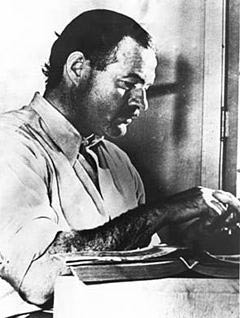Ernest Hemingway Biography Motivational Story
“There are events which are so great that if a writer has participated in them his obligation is to write truly rather than assume the presumption of altering them with invention.”
- Ernest Hemingway – Preface to The Great Crusade (1940) by Gustav Regler
 Ernest Hemingway (July 21, 1899 – July 2, 1961) was an American author and journalist whose unique writing style had a strong influence on 20th century fiction and culture. Many of his books are considered classics of American literature.
Ernest Hemingway (July 21, 1899 – July 2, 1961) was an American author and journalist whose unique writing style had a strong influence on 20th century fiction and culture. Many of his books are considered classics of American literature.“There is nothing noble in being superior to your fellow man; true nobility is being superior to your former self.”
— Ernest Hemingway
Hemingway was born in Oak Park, Illinois. After leaving school he worked as a journalist for the Kansas City City Star. However, after a few months, he enlisted with the Red Cross to volunteer as an ambulance driver. He was sent to the Italian front where he saw the horrors of the trench war. In 1918, he was seriously wounded from mortar fire and he was sent home to recuperate. He was awarded the Italian Silver Medal of bravery for helping an Italian soldier – despite his injuries. He later wrote a fictional book, based on his experiences in the 1922 novel – A Farwell to Arms. The main character in the book, is an ambulance driver who becomes disillusioned with the war.
After recovering from his injuries he moved to Chicago and then Paris, where he spent much of the inter-war years. He worked as a correspondent for the Toronto Star, and became acquainted with many modernist writers, such as James Joyce, Gertrude Stein and Erza Pound who lived in Paris at the time.
“If you are lucky enough to have lived in Paris as a young man, then wherever you go for the rest of your life, it stays with you, for Paris is a moveable feast.”
— Ernest Hemingway, A Moveable Feast
In 1937, he went to Spain to cover the Spanish civil war. He advocated international support for the Popular Front – fighting the fascists led by Franco. He later wrote a book – For Whom the Bell Tolls, which captures the struggles and brutality of the Spanish civil war. During the Second World War he continued to work as a foreign correspondant. He was present at the Normandy landings and the liberation of Paris.
In the 1950s, Hemingway was involved in two plane crashes which left him seriously injured and in pain for the rest of his life. He was awarded the Pulitzer Prize in 1953, and in October 1954, Hemingway was awarded the Nobel Prize in Literature for.
“his mastery of the art of narrative, most recently demonstrated in The Old Man and the Sea, and for the influence that he has exerted on contemporary style.”
Hemingway’s style had some similarities to other modernist writers. It was a reaction action the more elaborate, turgid style of the nineteenth century. It was direct, minimalist often leaving things unstated, but at the same time profoundly moving for bringing the reader into the heart of the story and experience.
“All good books are alike in that they are truer than if they had really happened and after you are finished reading one you will feel that all that happened to you and afterwards it all belongs to you: the good and the bad, the ecstasy, the remorse and sorrow, the people and the places and how the weather was. If you can get so that you can give that to people, then you are a writer.”
— Ernest Hemingway
Hemingway termed his style the Iceberg theory.
If a writer of prose knows enough of what he is writing about he may omit things that he knows and the reader, if the writer is writing truly enough, will have a feeling of those things as strongly as though the writer had stated them. The dignity of movement of an ice-berg is due to only one-eighth of it being above water. A writer who omits things because he does not know them only makes hollow places in his writing.
—Ernest Hemingway in Death in the Afternoon
Hemingway said the facts float above the water, but the structure is kept out of sight. Behind the minimalist prose is great effort, but the result is simplicity, immediacy and clarity.
In 1959 he moved from Cuba to Ketchum Idaho. However, tragically tormented by the pain of the plane crashes, he committed suicide in the summer of 1961.
He was married four times.

No comments:
Post a Comment